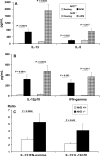Disruption of the transcription factor Nrf2 promotes pro-oxidative dendritic cells that stimulate Th2-like immunoresponsiveness upon activation by ambient particulate matter
- PMID: 18802057
- PMCID: PMC3086516
- DOI: 10.4049/jimmunol.181.7.4545
Disruption of the transcription factor Nrf2 promotes pro-oxidative dendritic cells that stimulate Th2-like immunoresponsiveness upon activation by ambient particulate matter
Abstract
Oxidative stress is important in dendritic cell (DC) activation. Environmental particulate matter (PM) directs pro-oxidant activities that may alter DC function. Nuclear erythroid 2 p45-related factor 2 (Nrf2) is a redox-sensitive transcription factor that regulates expression of antioxidant and detoxification genes. Oxidative stress and defective antioxidant responses may contribute to the exacerbations of asthma. We hypothesized that PM would impart differential responses by Nrf2 wild-type DCs as compared with Nrf2(-/-) DCs. We found that the deletion of Nrf2 affected important constitutive functions of both bone marrow-derived and highly purified myeloid lung DCs such as the secretion of inflammatory cytokines and their ability to take up exogenous Ag. Stimulation of Nrf2(-/-) DCs with PM augmented oxidative stress and cytokine production as compared with resting or Nrf2(+/+) DCs. This was associated with the enhanced induction of Nrf2-regulated antioxidant genes. In contrast to Nrf2(+/+) DCs, coincubation of Nrf2(-/-) DCs with PM and the antioxidant N-acetyl cysteine attenuated PM-induced up-regulation of CD80 and CD86. Our studies indicate a previously underappreciated role of Nrf2 in innate immunity and suggest that deficiency in Nrf2-dependent pathways may be involved in susceptibility to the adverse health effects of air pollution in part by promoting Th2 cytokine responses in the absence of functional Nrf2. Moreover, our studies have uncovered a hierarchal response to oxidative stress in terms of costimulatory molecule expression and cytokine secretion in DCs and suggest an important role of heightened oxidative stress in proallergic Th2-mediated immune responses orchestrated by DCs.
Figures










Similar articles
-
Nuclear erythroid 2 p45-related factor 2 inhibits the maturation of murine dendritic cells by ragweed extract.Am J Respir Cell Mol Biol. 2010 Sep;43(3):276-85. doi: 10.1165/rcmb.2008-0438OC. Epub 2009 Oct 5. Am J Respir Cell Mol Biol. 2010. PMID: 19805484 Free PMC article.
-
Nrf2 deficiency in dendritic cells enhances the adjuvant effect of ambient ultrafine particles on allergic sensitization.J Innate Immun. 2013;5(6):543-54. doi: 10.1159/000347060. Epub 2013 Apr 9. J Innate Immun. 2013. PMID: 23595026 Free PMC article.
-
Radical-containing particles activate dendritic cells and enhance Th17 inflammation in a mouse model of asthma.Am J Respir Cell Mol Biol. 2011 Nov;45(5):977-83. doi: 10.1165/rcmb.2011-0001OC. Epub 2011 Apr 14. Am J Respir Cell Mol Biol. 2011. PMID: 21493781 Free PMC article.
-
Air particulate matter induced oxidative stress and inflammation in cardiovascular disease and atherosclerosis: The role of Nrf2 and AhR-mediated pathways.Toxicol Lett. 2017 Mar 15;270:88-95. doi: 10.1016/j.toxlet.2017.01.017. Epub 2017 Feb 9. Toxicol Lett. 2017. PMID: 28189649 Review.
-
The role of oxidative stress in ambient particulate matter-induced lung diseases and its implications in the toxicity of engineered nanoparticles.Free Radic Biol Med. 2008 May 1;44(9):1689-99. doi: 10.1016/j.freeradbiomed.2008.01.028. Epub 2008 Feb 13. Free Radic Biol Med. 2008. PMID: 18313407 Free PMC article. Review.
Cited by
-
TIPE2 May Target the Nrf2/HO-1 Pathway to Inhibit M1 Macrophage-Related Neutrophilic Inflammation in Asthma.Front Immunol. 2022 Apr 28;13:883885. doi: 10.3389/fimmu.2022.883885. eCollection 2022. Front Immunol. 2022. PMID: 35572500 Free PMC article.
-
Modulation of Rho-Rock signaling pathway protects oligodendrocytes against cytokine toxicity via PPAR-α-dependent mechanism.Glia. 2013 Sep;61(9):1500-1517. doi: 10.1002/glia.22537. Epub 2013 Jul 10. Glia. 2013. PMID: 23839981 Free PMC article.
-
The impact of the Clean Air Act.J Pediatr. 2012 Nov;161(5):781-6. doi: 10.1016/j.jpeds.2012.06.064. Epub 2012 Aug 21. J Pediatr. 2012. PMID: 22920509 Free PMC article. No abstract available.
-
Particulate matter disrupts human lung endothelial barrier integrity via ROS- and p38 MAPK-dependent pathways.Am J Respir Cell Mol Biol. 2010 Apr;42(4):442-9. doi: 10.1165/rcmb.2008-0402OC. Epub 2009 Jun 11. Am J Respir Cell Mol Biol. 2010. PMID: 19520919 Free PMC article.
-
Nrf2 Involvement in Chemical-Induced Skin Innate Immunity.Front Immunol. 2019 May 7;10:1004. doi: 10.3389/fimmu.2019.01004. eCollection 2019. Front Immunol. 2019. PMID: 31134077 Free PMC article. Review.
References
-
- Walters DM, Breysse PN, Schofield B, Wills-Karp M. Complement factor 3 mediates particulate matter-induced airway hyperresponsiveness. Am. J. Respir. Cell Mol. Biol. 2002;27:413–418. - PubMed
-
- Williams MA, Porter M, Guo J, Roman J, Williams D, Breysse PN, Georas SN. Ambient particulate matter directs non-classical immuno-logical activation of dendritic cells and promotes Th2-like polarization. J. Allergy Clin. Immunol. 2007;119:488–497. - PubMed
-
- Saxon A, Diaz-Sanchez D. Air pollution and allergy: you are what you breathe. Nat. Immunol. 2005;6:223–226. - PubMed
-
- Dominici F, McDermott A, Daniels M, Zeger SL, Samet JM. Revised analyses of the National Morbidity, Mortality, and Air Pollution Study: mortality among residents of 90 cities. J. Toxicol. Environ. Health A. 2005;68:1071–1092. - PubMed
Publication types
MeSH terms
Substances
Grants and funding
LinkOut - more resources
Full Text Sources
Other Literature Sources
Molecular Biology Databases
Research Materials

